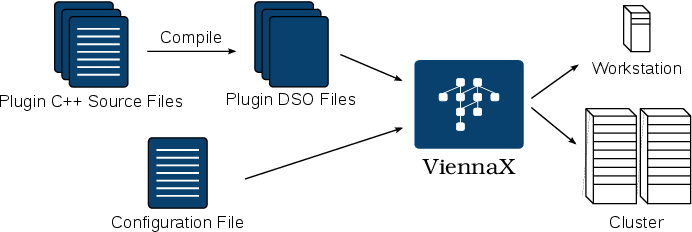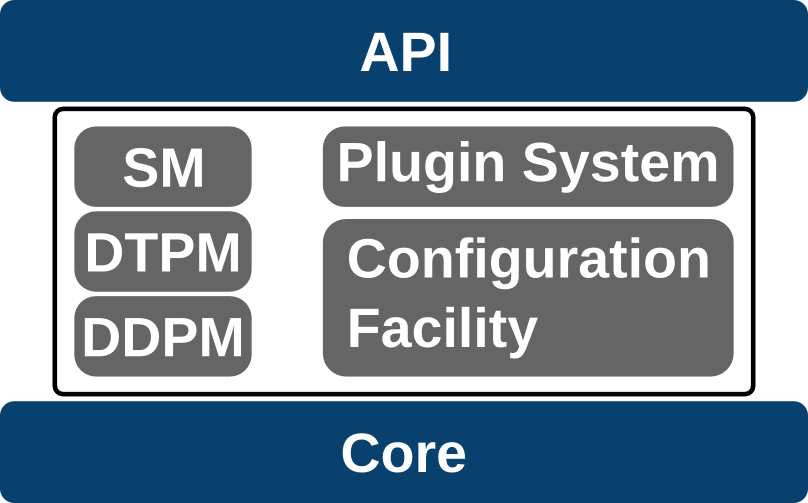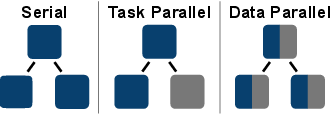
ViennaX can be seen as a plugin execution framework. Available simulation tools or components can be wrapped by plugins and therefore reused. An application is thus constructed by executing a set of plugins. The input configuration file based on the XML contains information indicating the plugins to be utilized during the course of the execution. Additionally, parameters can be provided by this configuration file, which are forwarded to the respective plugins by the framework.
Plugins can have data dependencies, which are internally represented by a task graph and handled by the so-called socket system. Different scheduler kernels are available, focusing on different execution approaches, being serial, task parallelism, and data parallelism, respectively. These applications can be used to execute the graphs generated from the input XML file.
Figure 5.11 schematically depicts the general execution flow of the framework. Plugins are implemented and compiled as dynamic shared objects ( DSOs), which are forwarded to the framework’s application. In addition to the plugins, the input configuration file is passed to the application. The schedulers automatically generate and execute the task graph according to the data dependencies. The intended target platforms are workstations or clusters, which are supported by different distributed scheduler kernels based on the MPI. More specifically, the Boost MPI Library [49] is utilized to support distributed-memory parallelization (Section 5.1.2). Our approach does not wrap the parallel execution layer of the target platform like MPICH [152].

As such, the framework is executed as a typical application utilizing the respective parallelization library. For instance, to execute an MPI capable scheduler application, the following expression is used.
In this case the mpiexec command spawns the execution of four instances.
vxscheduler relates to the application, whereas configuration.xml refers to the XML input
file holding the required information to build the task graph. The final parameter
plugins refers to the directory path, containing the plugins to be utilized during the
execution.
Different scheduler kernels, those being the serial mode ( SM), distributed task parallel mode ( DTPM), and distributed data parallel mode ( DDPM) scheduler, as well as the plugin system and the configuration facility are accessible via an API (Figure 5.12). The API enables software developers amongst others to implement or adapt schedulers. The design of the framework allows for different task execution modes implemented by the respective scheduler kernels to support, for instance, different parallel task graph execution strategies.

Table 5.1 discusses the available scheduler kernels. The SM-based kernel processes one plugin at a time, where the individual plugins run either serial and/or parallel shared-memory-parallelized implementations restricted to a single process, such as OpenMP. The DTPM kernel models the task parallel concept in an MPI context, where plugins are executed in parallel by different MPI processes, if the respective dependencies are satisfied. Consequently, applications with parallel paths in the graph can benefit from such a scheduling approach, such as the already indicated wave front simulations [149]. Finally, the DDPM kernel allows for a data parallel approach, where, although each plugin is processed consecutively, the plugins’ implementation follows an MPI-based parallelization approach. Such an approach allows, for instance, to utilize an MPI-based linear solver component within a plugin, such as PETSc [122]. Figure 5.13 schematically compares the principles of the different execution modes, by mapping components to vertices6 of a graph.

The currently implemented parallel scheduler focus on the distributed MPI. To better support the ongoing development of continually increasing core numbers per computing target, scheduler kernels utilizing shared-memory parallelization approaches are planned for future extensions. These future extensions are supported by the introduced naming scheme for the scheduler kernels as well as by the applied modular kernel approach.